Equity Savings as a category: PGIM India Equity Savings Fund

With the stock market at record highs, many investors are focusing on asset allocation. Hybrid mutual funds provide a variety of asset allocation solutions for investors with different risk profiles. In this monthly series we will discuss different hybrid fund categories with spotlight on hybrid products from PGIM India stable. In this article, we will discuss about equity savings fund category and PGIM India Equity Savings Fund. But first, a quick overview of hybrid funds:-
Different types of hybrid funds
- Aggressive hybrid funds: 65% to 80% equity and 20% to 35% debt. Suitable for investors with adequately high risk appetite.
- Balanced hybrid funds: 40% to 60% equity and 40% to 60% debt. Suitable for investors with moderate to moderately high risk appetite.
- Dynamic asset allocation funds / Balanced Advantage funds: Manage asset allocation between equity and debt dynamically based on market conditions. Suitable for investors with moderate to moderately high risk appetite.
- Multi asset allocation funds: Minimum 10% asset allocation in at least 3 classes e.g. equity, debt, gold. Suitable for investors with moderate to moderately high risk appetite.
- Equity savings funds: Gross equity exposure of minimum 65%, hedging is allowed, minimum 10% in debt. Usually positioned as a lower risk fund compared to other hybrid funds, except conservative hybrid funds and arbitrage funds.
- Conservative hybrid funds: 10% to 25% equity and 75% to 90% debt. Suitable for investors with moderately low to moderate risk appetite.
- Arbitrage funds: Uses arbitrage strategy with gross equity exposure of minimum 65%. Suitable for investors with low risk appetite.
Equity Savings Funds – A brief background
These funds were launched after the minimum holding period for long term capital gains taxation of debt funds was increased to 3 years in 2014. Equity savings funds were positioned as tax efficient investments for conservative investors. Since the gross equity exposure of these funds is at least 65%, they enjoy equity taxation. Short term capital gains (holding period of less than 1 year) in equity savings funds are taxed at 15%. Long term capital gains (holding period of more than 1 year) are tax exempt up to Rs 1 lakh in a financial year and taxed at 10% thereafter. On the other hand, capital gains in debt funds, irrespective of holding period are added to your income and taxed as per your income tax rate. However, apart from the taxation considerations, there are other compelling reasons for an investor to look at equity savings funds for the medium to long term. Read on to find out more.
How equity savings funds work?
Equity savings funds typically invest in equity, debt and arbitrage opportunities.
- Arbitrage: Arbitrage is defined as risk free profit, by exploiting pricing mismatches in the market. A simple example of arbitrage is cash and carry, where you buy a stock and simultaneously sell futures of the same underlying stock. The futures premium or spread is risk free profit, irrespective of whether the share price moves up or down (see the table below). The arbitrage portion generates returns and also ensures equity taxation.

- Debt and Money Market: The fixed income / money market portion of the portfolio generates income and provides stability in volatile markets. Fund managers usually employ accrual strategy or may take duration calls depending on their interest rate outlook.
- Active Equity: Equity savings funds take active (un-hedged) exposure within specified allocation ranges. Fund managers may increase or decrease active equity exposure depending on market conditions. The proportion of active or unhedged equity, also known as Net Equity, and the hedged equity (arbitrage portion) determines the risk profile of individual equity savings funds. Different equity savings fund may have different risk profiles depending on their net equity exposures.
Risks at a scheme level within the peer group may vary considerably
A common mistake which some investors make is to consider category level risk when investing in a mutual fund scheme. Within some hybrid fund categories, scheme level risks can vary considerably. In the scatter plot diagram below, we plotted 3 year CAGR returns (as on 31st August 2023) versus standard deviations of all the schemes in the equity savings funds category. While the 3 year returns are spread over a range from 7%to 14%, the standard deviations are also spread over a range of 3.5% to 7%.You can see that the schemes circled in red were able to generate superior risk adjusted returns; one of the schemes is PGIM India Equity Savings Fund.
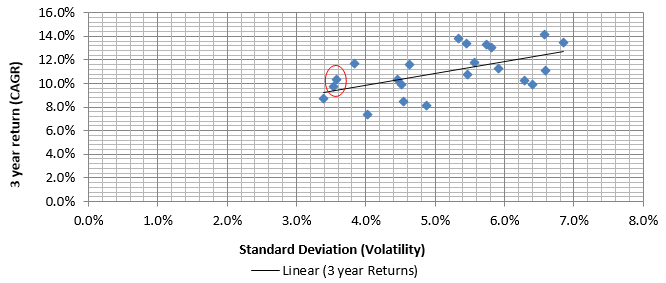
Source: Advisorkhoj Research, as on 31st August 2023
The chart below shows the net equity levels of different schemes in the equity savings category as on 31st August 2023. You can see that most schemes in this category maintain net equity levels from 25% to 40%. PGIM India Equity Savings Fund (circled in dark blue) has the lowest net equity exposure among all equity savings schemes. Funds with lower equity exposure may align to client needs, and also helps the category attain a clearer positioning, that of being a viable alternative to fixed income products with relatively low additional risk.
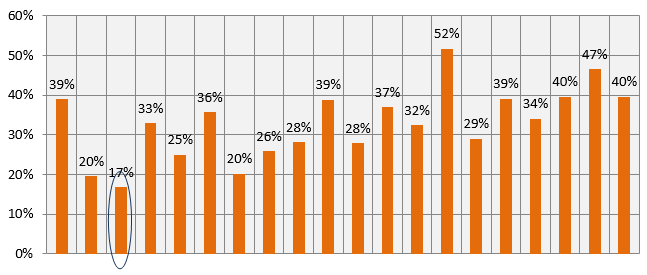
Source: Advisorkhoj Research, as on 31st August 2023. Only funds which have disclosed net equity exposures in monthly factsheets are shown in this chart.
Drawdowns can vary significantly
We have calculated and plotted the drawdowns of all the schemes in Equity Savings category when the equity market crashed in March 2020 due to the outbreak of the COVID-19 pandemic (see the chart below). You can see that the corrections ranged from -8% to -24%. PGIM India Equity Savings Fund (circled in dark blue) had a smaller drawdown compared to average (-16%).
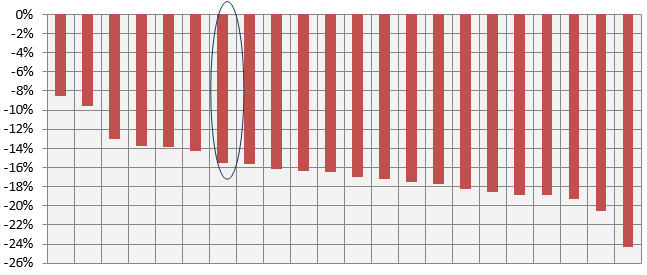
Source: Advisorkhoj Research, 20th February 2020 to 23rd March 2020.
About PGIM India Equity Savings Fund
This fund was previously known as DHFL Pramerica Equity Income Fund. In 2019, PGIM India Mutual Fund completed the acquisition of DHFL Pramerica AMC. PGIM India Equity Savings Fund has Rs 100 crores of assets under management (as on 31st August 2023) and its total expense ratio is 1.31% for the regular plan (as on 31st August 2023). The fund has given around 7.6% CAGR returns since its takeover by PGIM in July 2019 (as on 31st August 2023). A. Anandha Padmanabhan, Vinay Paharia, Hitash Dang and Puneet Pal are the fund managers of the scheme. The fund managers have combined experience of over 80 years.
Investment Strategy - PGIM India Equity Savings Fund
- 15% to 20% of the portfolio is invested in net equity (unhedged) to benefit from the upside in the equity markets. Both top down and bottom up approaches are used to invest in equity and equity related instruments. Currently the scheme is maintaining around 17% net equity, which is significantly lower than average net equity exposures of peer funds.
- The debt allocation is actively managed and the Fund Management team endeavours to generate returns whilst moderating credit and interest rate risk. Up to 35% of the portfolio is invested in money market instruments and medium to long term bonds, including G-Secs.
- About 45% to 50% of the portfolio would be generally invested in equity arbitrage positions to cushion the volatility in returns.
Scheme Performance - PGIM India Equity Savings Fund
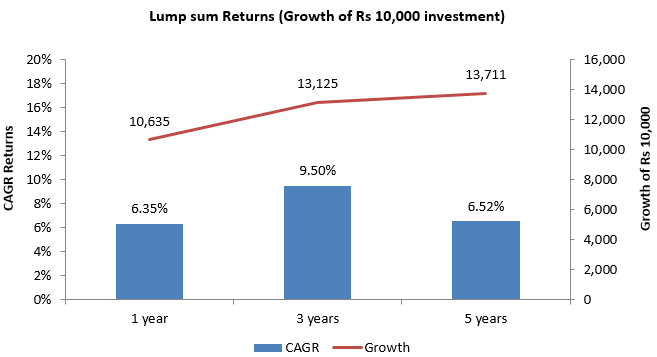
Source: Advisorkhoj Research, as on 31st August 2023
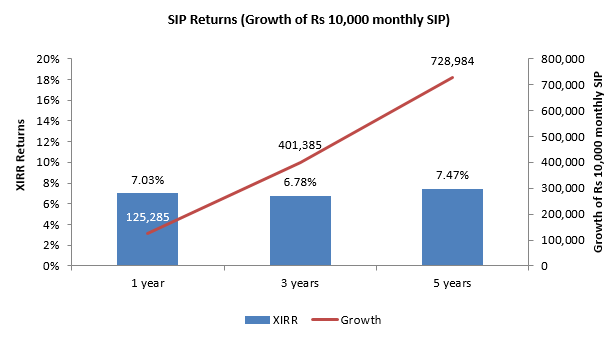
Source: Advisorkhoj Research, as on 31st August 2023
Why invest in PGIM India Equity Savings Funds?
- In the current market scenario, where interest rates are showing a hardening trend and infl-ation expectations in India and abroad have risen, moderate to conservative investors are left with fewer options to park their money for the medium to long term, in a tax-efficient manner.
- At the same time, these investors may not be comfortable taking exposure to pure equity-oriented products as volatility has risen and even though economies globally are showing recovery and there is robust earnings growth exhibited by companies, there may be uncertainty in the future on the back of geo-political tensions and other concerns.
- The 3-pronged approach of PGIM India Equity Savings Funds with each asset class having a different role to perform looks to provide a solution to all types of investors fulfilling different investment goals.
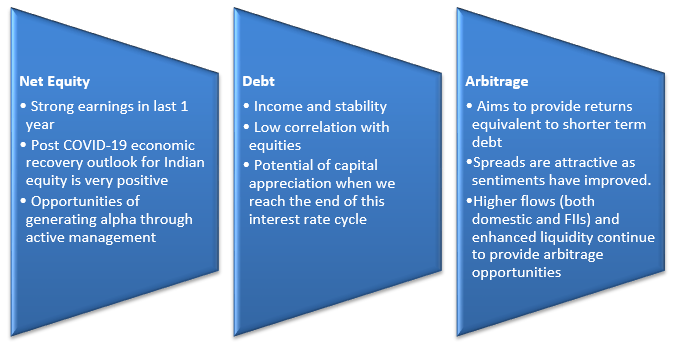
- The risk profile of PGIM India Equity Savings Fund is on the lower side compared to peers in the Equity Savings category. As such, investors who do not have high appetite for volatility can consider investing in PGIM India Equity Savings Fund. The fund can generate tax efficient returns with relatively low downside risks.
Investors should consult with their financial advisors or mutual fund distributors if PGIM India Equity Savings Fund is suitable for their investment needs.
Mutual Fund Investments are subject to market risk, read all scheme related documents carefully.
PGIM is the global investment management business of Prudential Financial, Inc. (PFI) USA, with USD 1.5 trillion1 in assets under management. We offer a broad range of investment capabilities through our multi-manager model along with experienced investment teams that assist you in achieving your financial goals. With a glorious legacy of 145 years, PGIM is built on the strength, stability and deep expertise in managing money. We offer you a long-term perspective, having weathered multiple market cycles, and see opportunity in periods of disruption.
Investor Centre
Follow PGIM India MF
More About PGIM India MF
POST A QUERY










